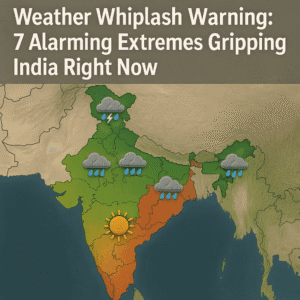Weather Whiplash Warning: 7 Alarming Extremes Gripping India Right Now
India faces severe weather extremes simultaneously this week. The Northeast, particularly Assam and Meghalaya under an Orange Alert, braces for life-threatening heavy rains until June 7th, with high risks of flash floods, landslides, and waterlogging requiring immediate vigilance in vulnerable areas. Meanwhile, North India including Delhi anticipates thunderstorms and strong gusty winds today and Thursday, disrupting daily life.
In stark contrast, Odisha and West Bengal endure dangerous, persistent heatwaves with temperatures rising further, posing serious health risks, especially alongside oppressive humidity in southern coastal states. Southern India sees beneficial early monsoon rains bringing relief to Kerala, Karnataka, and Andhra Pradesh, though localized heavy downpours remain possible. This national snapshot highlights urgent regional dangers – from flooding and storms to extreme heat – demanding tailored precautions from affected residents.

Weather Whiplash Warning: 7 Alarming Extremes Gripping India Right Now
The skies over India paint a picture of dramatic contrasts this week, delivering everything from life-threatening deluges to blistering heatwaves. While Delhi enjoys a brief respite, the real story lies in the intense regional disparities demanding attention and preparation.
- Delhi & Northwest: A Fleeting Respite Before Turbulence Returns
- Current Scene: Residents woke to welcome overcast skies and cooler temperatures (min 22-24°C, max 35-37°C), a break from recent highs.
- Immediate Threat: Don’t put away the umbrellas. The IMD forecasts thunderstorms, gusty winds (up to 50 kmph), and light rain for Wednesday and Thursday. This instability, driven by a western disturbance and cyclonic circulation over Punjab/Haryana, extends across:
- Jammu & Kashmir
- Himachal Pradesh (risk of severe thundersqualls up to 70 kmph, hail)
- Uttarakhand
- Punjab
- Haryana
- Uttar Pradesh
- Rajasthan
- Human Angle: Commuters should brace for sudden disruptions. Secure loose objects outdoors, be cautious of falling branches, and expect potential traffic delays. Farmers in western UP, Haryana, and Rajasthan should monitor for isolated heavy rain impacting standing crops.
- Northeast (Assam & Meghalaya): Orange Alert – Flooding & Landslide Danger Peaks
- Critical Warning: An IMD Orange Alert signals heavy to very heavy rainfall in isolated parts of Assam and Meghalaya on Wednesday. This isn’t just rain; it’s a catalyst for disaster.
- Tangible Risks: Authorities urgently warn of:
- Flash Floods: Sudden, destructive surges of water, particularly dangerous in valleys and near rivers.
- Severe Waterlogging: Paralyzing urban and rural areas, damaging property, and contaminating water sources.
- Landslides: A major threat in hilly and vulnerable terrain, potentially cutting off villages and roads (as seen in Hojai, Assam, requiring boat rescues).
- Duration: The intense downpour is expected to persist until at least June 7th. While Nagaland, Manipur, Mizoram, and Tripura may see reduced intensity from Thursday, Assam and Meghalaya remain firmly in the danger zone.
- Human Imperative: Residents in low-lying and landslide-prone areas must heed evacuation advisories immediately. Ensure access to emergency kits, safe drinking water, and elevated shelter. Community coordination is vital.
- East India (Odisha & West Bengal): Relentless Heatwave Scorches Lives
- Enduring Scorch: While the north gets rain, Odisha and Gangetic West Bengal bake. Heatwave conditions are forecast:
- Odisha: Until at least June 6th.
- West Bengal: Through June 4th.
- Escalating Temperatures: Expect a further rise of 2-3°C in maximum temperatures across eastern India in the next 48 hours.
- Humidity Adds Misery: Coastal Andhra Pradesh, Tamil Nadu, and Puducherry face oppressive heat coupled with high humidity, significantly increasing heat stress and health risks (heat exhaustion, stroke).
- Human Toll: This is especially dangerous for outdoor workers, the elderly, children, and those without reliable cooling. Strict adherence to heat advisories – avoiding peak sun, staying hydrated, and recognizing heat illness symptoms – is non-negotiable.
- Southern India: Early Monsoon Brings Cautious Optimism
- Welcome Showers: The advancing Southwest Monsoon brings light to moderate rainfall to:
- Kerala
- Coastal Karnataka
- Parts of Andhra Pradesh (continuing through Thursday).
- Heavier Spots: Isolated heavy rainfall is likely over Kerala and Coastal Karnataka on Wednesday.
- Thunderstorm Potential: Telangana and interior Karnataka could see thunderstorms with gusty winds (~40 kmph).
- Human Benefit: These early rains offer crucial relief from summer heat and provide valuable moisture for agricultural preparation. However, localized heavy downpours can still cause temporary disruption.
The Big Picture: A Nation in Climatic Contrast
India is simultaneously experiencing the fury of pre-monsoon instability in the north, the extreme flood risk of intensified northeastern rainfall, the dangerous persistence of eastern heatwaves, and the hopeful onset of southern monsoonal rains. This underscores the vast and varied weather challenges across the subcontinent.
Staying Safe: What This Means for You
- North/Northwest: Enjoy the cool morning but prepare for afternoon/evening storms. Secure belongings, avoid travel during intense weather.
- Northeast (Assam/Meghalaya): Treat the Orange Alert with utmost seriousness. Evacuate if advised, avoid flooded roads and rivers, monitor landslide risks near slopes.
- East (Odisha/WB): Prioritize heat safety. Stay indoors during peak heat, hydrate constantly, wear light clothing, check on vulnerable neighbors.
- South: Welcome the rain but stay alert for localized heavy downpours or gusty winds, especially in Kerala and Coastal Karnataka.
This isn’t just weather reporting; it’s a map of evolving risks and necessary actions across India. Staying informed through official IMD updates and local disaster management authorities is crucial for navigating these extreme conditions safely.
You must be logged in to post a comment.